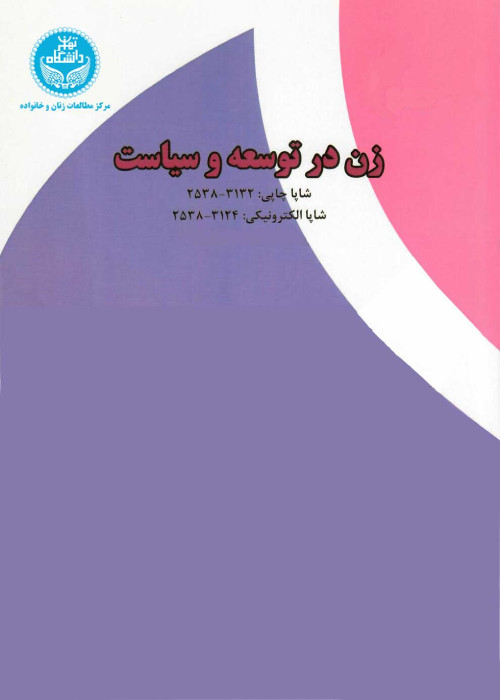An analysis of women's Education and Economic Status in healthcare use during pregnancy
Author(s):
Abstract:
During the past decade there has been an unceasing trend to reduce child and maternal mortality rate، and thus a demand to examine and address the existing challenges. Despite the importance of consistent healthcare during pregnancy، childbirth and postpartum period، some Iranian women are not currently using these types of services. Therefore، the study on the important parameters that can lead to lack of enthusiasm and inclination to use healthcare services is significant. The Data for the study is drawn from Iran DHS-type survey conducted in 2000 by the Ministry of Health and Medical Education of Iran. A total of 114،000 households with a total population of about 537،000 are representatively selected from rural and urban areas of 28 provinces، plus an additional sample from the capital city of Tehran. Data analysis involves a use of logistic Regression to predict the probability of healthcare use based on independent variables. The conceptual framework of the study is based on Anderson’s social model of healthcare use. Independent variables are demographic variables including age، birth، residence، experience of abortion and stillbirth as well as socio-economic variables including education، employment، economic indicator and health condition in household. The study indicates that around 8. 6 percent of the total pregnant women of the study do not use any healthcare services. The proportion of not using healthcare services is 6% and 12% in urban and rural areas respectively. In terms of frequency of referral and quality of cares، there exist large differences between urban and rural centers as well. Considering the economic index، the difference is however much greater. In the group with low economic status، 30% of women have not referred to any healthcare center to get reproductive healthcares. This figure decreases to 4. 5% for those with high economic status. In terms of education، 25% of illiterate people have not referred to any healthcare center. The ratio of not using healthcare among literate women with elementary and high school education decreases to 6. 5% and 2% respectively. The study indicates that the economic index has a significant influence on healthcare use. Meanwhile، the odds ratio for those with medium and high economic status is 3. 1 and 9. 25 respectively as compared to 1 in low economic status. Thus، education is more influential among independent variables. As the illiterate women are considered as reference group، the odds ratio for women with elementary، high school and university education is 4. 8، 27 and 56 respectively. In terms of demographic variables the birth order is a very effective variable. With more children، the probability of using healthcare services becomes less. It is also found that the maternal healthcare use is related inversely to age. The higher the age of respondents is، the lower the probability of healthcare use will be. Considering the population of pregnant women in Iran، this percentage includes a high number of women who do not use reproductive healthcare services. However، for the number of women interested in using such healthcares، a significant proportion complain about the poor quality and quantity of the offered services. As the study indicates، education and knowledge about contraception has the most stable effect in the models which indicate the significance of Ideational factors in reproductive healthcare use. The economic status is of second importance in predicting the use of healthcares.
Language:
Persian
Published:
Women in Development and Politics, Volume:8 Issue: 4, 2011
Page:
183
magiran.com/p818558
دانلود و مطالعه متن این مقاله با یکی از روشهای زیر امکان پذیر است:
اشتراک شخصی
با عضویت و پرداخت آنلاین حق اشتراک یکساله به مبلغ 1,390,000ريال میتوانید 70 عنوان مطلب دانلود کنید!
اشتراک سازمانی
به کتابخانه دانشگاه یا محل کار خود پیشنهاد کنید تا اشتراک سازمانی این پایگاه را برای دسترسی نامحدود همه کاربران به متن مطالب تهیه نمایند!
توجه!
- حق عضویت دریافتی صرف حمایت از نشریات عضو و نگهداری، تکمیل و توسعه مگیران میشود.
- پرداخت حق اشتراک و دانلود مقالات اجازه بازنشر آن در سایر رسانههای چاپی و دیجیتال را به کاربر نمیدهد.
دسترسی سراسری کاربران دانشگاه پیام نور!
اعضای هیئت علمی و دانشجویان دانشگاه پیام نور در سراسر کشور، در صورت ثبت نام با ایمیل دانشگاهی، تا پایان فروردین ماه 1403 به مقالات سایت دسترسی خواهند داشت!
In order to view content subscription is required
Personal subscription
Subscribe magiran.com for 70 € euros via PayPal and download 70 articles during a year.
Organization subscription
Please contact us to subscribe your university or library for unlimited access!



